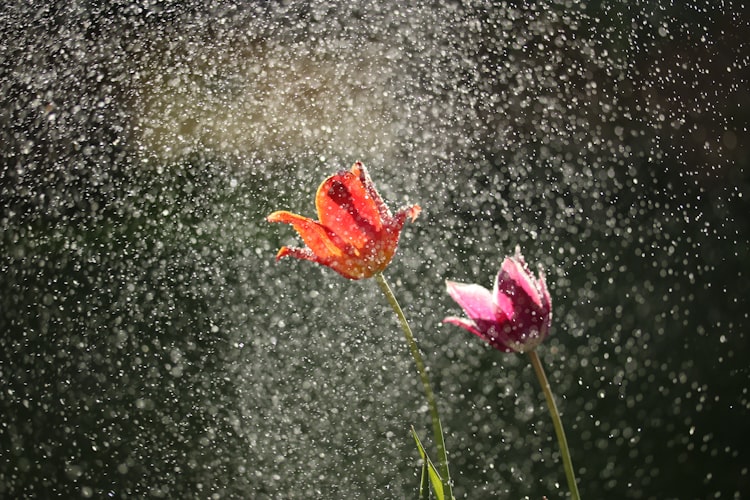10 Common Gardening Mistakes

If you are new to gardening, you may make some errors as you learn about how to design and tend to your outdoor space. Here are ten of the most common mistakes you should try to avoid in your garden:
Overcrowding Plants
This is a common mistake for many beginner gardeners. You buy a bunch of plants that you like the look of in the nursery and start planting them in your garden closely together because they look good at their current size. Unless you are going to replace all your plants every season, this can quickly turn into an overgrown mess of plants.
The way to avoid this mess is to space plants apart based on their mature widths. If a plant is going to grow to 4ft wide, space the plants 4ft from each other (measured from the middle of the plants). To prevent the garden from looking very empty while you wait for it to fill in as it grows out, use annuals and wildflowers to place in the empty spaces. Before you set off on a shopping trip for plants, measure your space to understand how much space you have to work with. This will prevent you from buying too many (or too little) plants for your garden.
Landscape Weed Fabric
Many beginner gardeners use landscape fabric to prevent weeds from growing in new garden beds. This is not a good idea for several reasons. The most important is that is not good for the environment to use large sheets of plastic that can remain in the soil for many years, long after their useful life.
It isn't as good at suppressing weeds as you might think. The fabric creates a layer above your existing soil that new soil will eventually collect on, either by blowing in or from mulch and leaves decaying on the surface. Weeds will grow into that upper layer, and many have strong enough roots that can tear through the fabric into the soil below. Once enough weeds have become entangled in the fabric, it then becomes very difficult to remove the weeds without disturbing the plants you want to have in the garden.
Another issue is that landscape fabric prevents water from collecting into the soil effectively because it acts as a filter and water will drain slowly or run off the edges. In heavy rainfall, this can result in water pooling on the surface, potentially causing root rot and other issues for plants.
A further problem with landscape fabric is that it tends to damage the soil underneath. The soil underneath the fabric will often become compacted, making it difficult for plants to grow healthy root systems.
A better solution for weed management is to use a bio-degradable plant barrier like paper or cardboard, and ensure there is always 3" of mulch on the surface of the soil. Sheet mulching is a much better way to eradicate and prevent weeds than using landscape fabric.
Poor Planting technique
When planting, you need to make sure the plants are planted properly. Always dig a hole that is twice the width of the plant's pot. By doing so, you will loosen the soil around the plant to help it absorb water and make it easier for the roots to establish into the new soil. Make sure the plant is watered before planting, the hole is watered before the plant is placed, and that the plant gets watered after the soil is refilled into the ground around the plant. Mulch around the plant should not be touching the crown of the plant.
Mulch Volcanoes
An all too common mistake with newly planted trees is to pile up mulch onto the trunk of the tree. When mulch is placed to create a mound or cone-shaped pile around the base this is referred to as a "Mulch Volcano". Mulch volcanoes can create several problems with trees.
The biggest problem with mulch volcanoes is that they can cause root girdling. This is when roots grow upwards into the mulch, creating a constriction effect on the trunk and major roots. This can impede water and nutrient uptake, leading to long-term health issues for the tree.
Excessive mulch piled against the tree trunk can trap moisture and create a damp environment. This can promote the growth of fungi and bacteria that may contribute to root rot and other diseases. Additionally, constant moisture against the trunk can lead to collar rot. Rot on the base of a tree is particularly dangerous as it can cause it to suddenly collapse without warning.
When mulch is piled against a tree trunk, it can also lead to deterioration of the bark. This can create an entry point for pathogens, insects, and diseases, increasing the risk of harm to the tree.
To prevent any potential issues, it is highly recommended to apply mulch in either a flat configuration or a donut shape with a gap around the base of the tree trunk (known as a mulch donut). This will ensure that there is proper air flow, which will prevent any excess moisture buildup, as well as reduce the risk of root girdling.
Nursery Stakes
Many tall plants will be staked in their pots at the nursery. For most plants, these should be removed when they are planted in your garden. Nurseries stake young plants to promote their vertical growth while containers are close together to save growing space. If you continue to use the stake in your garden, the plant's trunk will not strengthen sufficently. While it is true that some trees will need staking after planting, the stake used should be a different stake applied in a different manner than the one in the pot.
Not Examining Your Soil
You need to understand your soil before you start planning your garden. Some plants have preferences for different soil textures, and many are not tolerant of clay soils. Luckily, there is a simple test you can do to determine soil texture.
In addition to texture, soil also has differing pH levels and some plants have a preference for more acidic or more alkaline soil. To test this, you can buy soil testing strips to measure the pH levels in your soil.
Another issue with soil quality is commonly found in newer-built homes. It is not uncommon to discover that a few inches of topsoil was laid on the surface, and the soil below is full of construction debris. If you have a newly built home, dig down a few feet to make sure the soil is not very poor quality beneath the upper layer. Similarly, I have also discovered concrete patios buried under old lawns in some gardens so this is not just an issue in new homes, albeit a lot more common.
Poor Watering Technique
Make sure you understand the watering needs of your plants and set up a schedule for watering them consistently when they are newly planted. Unless a plant needs consistently wet soil, you should only water when the topsoil is dry. You can check this by placing your finger into the soil up to your second knuckle.
Place plants with similar watering needs in the same space. Make sure that you water your plants early in the morning or the evening. Watering in the middle of the day will just be wasting water as most of it will evaporate away in the sun.
Planting at the Wrong Time
Pay attention to the frost levels in your area. In frost-prone areas, the best time for planting perennials is in Spring, after the final frost of the year. Trees should be planted in Autumn so that their roots have more time to grow before their first Summer. In areas that do not get cold enough to worry about frost, you should be planting your garden in the Winter. For areas with dry summer climates, the planting should be done after the first major rain of the wet season.
Ignoring Wildlife
You should observe and make note of the types of wildlife that may enter your garden to ensure you are well prepared to manage any incursions into your plant beds. Common examples are deer and birds, and you'll have a hard time preventing them from entering your garden.
If you have a lot of deer in the area, avoid plants that deer like to graze on - many plant guides will offer lists of plants that deer not not like to eat. If you have a lot of birds in the area, they will eat seeds that you sow into your soil. Distract them with a bird feeder in that case as they will feel safer feeding from there.
Not Understanding Plant Hazards
Many plants can be hazardous to work with due to thorns, or oils on the foliage that can irritate your skin. Try to place thorny plants a good distance from walkways and away from other plants and walls/fences to make them easier to maintain.
If you have sensitive skin, make sure you are aware of the plants that can cause contact dermatitis and avoid using them or wear long sleeves and gloves when working around them. Lantana, Echium and Oleandar are common garden plants that can cause skin irritation.
A further risk is that some plants secrete a latex sap that is harmful to your skin and can create nasty burns. Be very careful working with Agaves and Euphorbia species as these are notorious for causing skin burns due to ther latex sap. Latex is also known to cause temporary blindness, so wear eye protection as well as gloves and clothing to protect the skin.





